|
|
|
|||
|
|
||||
|
|
||||
| Smoke Trails | ||||
|
|
HOME | SITE MAP | FORUM | CONTACT |
|
||
|
ABOUT | MOTORS | MODELS | ARCHIVE | HISTORY | STORE | FAQ | LINKS
|
|
|
|
|
|
||||||||||||||||||||||||||||||||||||||||||||||||||||||||||||||||||||||||||||||||||||||||||||||||||||||||||||||||||||||||||||||||||||||||
|
Smoke Trails 11
(April 2007)
by Roger Simmonds Originally published in SAM 35 Speaks, April 2007 The use of CO2 cartridges to ‘jet propel’ model aeroplanes seems to have been thought a good idea only in the USA, and then only for a short period just after the war. As far as I know, only Ray Models actually produced kits, three of which have made brief appearances in these columns before: the ‘Jet Racer’ in September ’04, and the ‘Jetwing’ and P-80 Shooting Star (their only scale model) in November ‘04. U.S. modeller Caley Hands recently obtained an example of the first Ray model, the so-called ‘Super Rocket’, and has kindly sent me pictures (right) and a plan (below). Nicely drawn and annotated, it gives details of an adjustable rudder, elevator and even ailerons with settings (“for advanced flyers only”) to achieve various flight patterns such as loops, double loops, barrel rolls, Immelman turns and ‘hedge hopping’. Launching instructions, single handed, two handed or ROG are also provided. 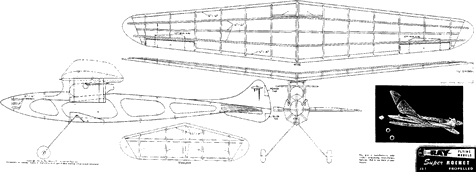 The 1944 ‘Super Rocket’ (detail from plan) |

- photo by Caley Hands
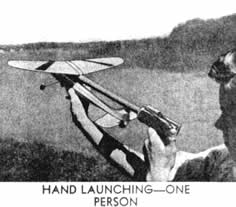 Launching technique: note the lack of safety glasses Hopefully, the gun pierces the cartridge in an efficacious and repeatable way. Looks scary, though
- Ray Models
|
||||||||||||||||||||||||||||||||||||||||||||||||||||||||||||||||||||||||||||||||||||||||||||||||||||||||||||||||||||||||||||||||||||||||
|
Ben Nead, who has researched their history, writes, “Ray Models were based in Philadelphia, Pennsylvania. Starting just before the end of WWII (as early as 1944 as far as I've been able to determine), their kits were, I believe, one of the first (if not the very first) commercially distributed line of ‘jet’ models to be made available to modellers. “It's doubtful that such a crude power plant as a simple punctured CO2 cartridge offered a reliable performance of any sort, and the models disappeared from the marketplace by around 1947. When Jetex motors became available in the latter half of 1948 they made the concept of the CO2 powered Ray Jets null and void. The models, however, survived – Curtis Mattikow of New York City seems to have an inexhaustible supply of these treasures unopened and in mint condition – and I'm sure that many were adapted to Jetex power over the years.” |
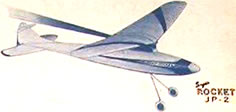
- photo by Caley Hands
|
||||||||||||||||||||||||||||||||||||||||||||||||||||||||||||||||||||||||||||||||||||||||||||||||||||||||||||||||||||||||||||||||||||||||
|
|
|
|||
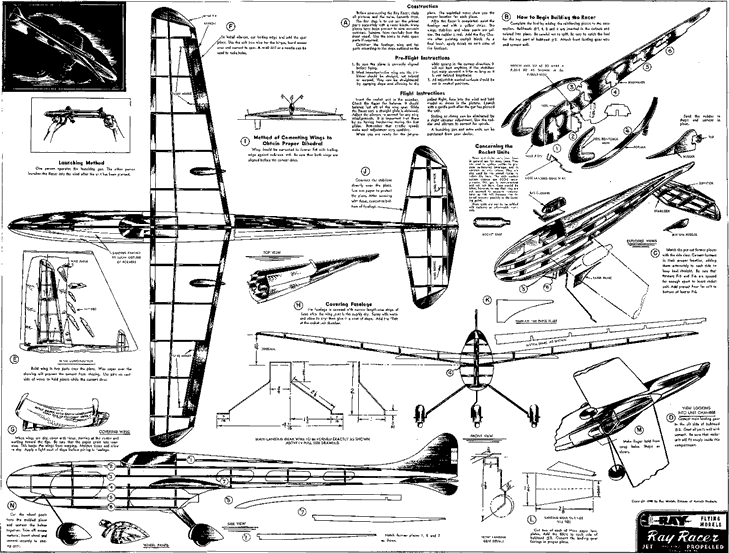 |
||||
|
Ray’s second model, the mid-wing Ray Racer (above), shared its forerunner’s dubious moveable control surfaces, but does show some progression from the Super Rocket, which looks, in truth, like a modified rubber powered model. However it is distinctly less futuristic than Haase’s much earlier model and several contemporaneous rocket planes, for example Roswell Brown’s Strato-Rocket, M. Dargère’s Sparkling Star and Howard Boys’ twin-boom Rocket Plane. However, 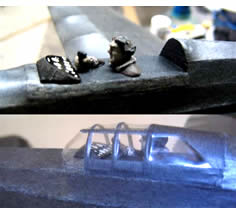
The Ray Racer took to the air at the 2006 Geneseo meeting (right) and exceeded all its builder’s expectations. Steve Bage, too, has a plan for this one (ask if you would like a copy) so I hope it won’t be too long before we see a Ray Racer at Old Warden. Steve threatens to leave off the tricycle undercarriage; this would be a pity as it does give the model a nice vintage feel. |
 
- Ronnie Gosselin
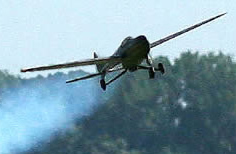
- Larry Marshall
|
|||

Ray’s third free-flight kit, the Jetwing, is something of a curiosity, being much inferior to Howard Boy’s Flaming Ptero, and I don’t think it’s been modelled in the last fifty years. The plan (right, courtesy of Pete Williams of ‘Pete’s Plans’) shows just how peculiar it is. A very high performance with a most unrealistic glide ratio of 15 was claimed; whether it could be trimmed to fly predictably is another matter. At least the instructions don’t tell you to fiddle with the control surfaces to achieve different aerobatics, and the builder is warned that the rudders are very sensitive because the model flies so fast. When Ben Nead first came across the Jetwing he commented, “I love the redundant elevator and the twin fins, it makes it look clunky in a 1940s kind of way”. Just so. Who will be the first brave soul to essay one with a Rapier? The Passing of Funf It was Stan Pearson, a. k. a. ‘Funf’ who first named our favourite pastime the ‘Smoky Addiction’. Despite his occasional pithy and acidulous comments about model jet planes (“Jets with stringers, I ask you!”) and the observation that Rapier flying was only for lottery winners, he was a consistent supporter of these columns. |
|
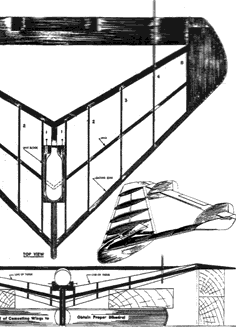 Ray Models Jetwing
- Pete Williams
|
||
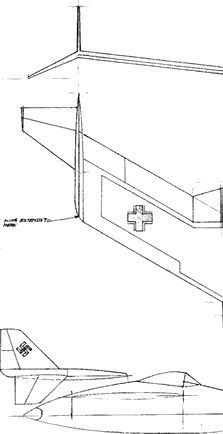
Stan ‘hand typed’ all his letters, and these were always encouraging and informative. He would have been amused at my latest round of computer problems, probably asking why I just didn’t get another typewriter ribbon. He was also generous in sending plans of Jetex profile models, and that great love of his, simple catapult gliders. So in commemoration of a great character, here is one of his own scale profile designs that he sent me some time ago and I have been saving up for an apposite occasion. Sadly, this is it. Stan opined that notwithstanding its unconventional layout it should fly very well. I’m sure this will be the case, as Steve Bage’s built up version is a real winner, approaching the performance of a duration model. Please ask if you would like a copy of Stan’s plan. |
|
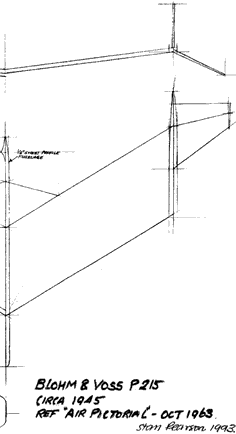 |
||
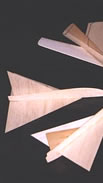
That these sorts of models, accessible to all who have a sheet of balsa, a kitchen table, a broken razor blade and a large elastic band are encouraged by a new generation of modellers would, I hope, have been a comfort to him. The long Lost Jetex Trophy |
|
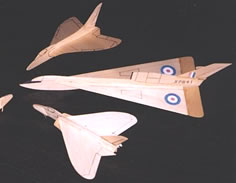 Deltacats |
||
|
Here is a story that Stan, coryphaeus that he was against any surrender, as he would have seen it, to the BMFA, would have appreciated. There will be several ‘Rapier Duration’ events this year, and some very competitive designs, ancient and modern, are available to the Rapier sportsperson, though (so far) he will have to build them for himself. But who will provide trophies for such competitions? Not ICI, that’s for sure. And what has happened to the old trophies? Where are they now? Andy Blackwell, looking through last August’s BMFA News, came across an article about an R/C ‘weightlifting challenge’ event, written by Dave Kershaw, Fellow. The report included a picture of the worthy winners (from Brunel University) being presented with a magnificent trophy by Robin Gowler, Fellow. All worthy stuff, if not the kind of thing we are interested in. But Andy, Chum of SAM, noticed that the large silver cup was brazenly identified as the ‘Jetex Trophy’. Well, I ask you! I wonder if Jeremy Mansour (just a Chum) could ask for it back, so it could be used again for its historic and proper purpose. I don’t see why not. But first, I suppose, we will all have to become Fellows. But, like Stan, all we really want to do is to muck about with our toys (not sporting equipment) and have fun. Finally, here is a plan that Stan would surely have approved of, and would complement his Super Sabre, which, according to Stan, could do a very nice ‘Sabre Dance’. 
First published in Aeromodeller, 1953, it hasn’t seen the light of day for some time. Howard Metcalfe found it on a yet another website. Very encouraging! Now where to fit the Rapier? Sorry, Funf. |
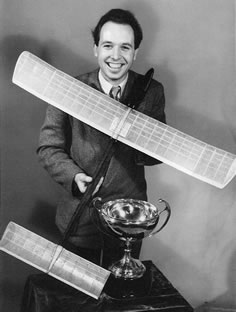 A young Bill Henderson with the fabled Jetex Trophy, which he won in 1951
- Bill Henderson
 Bill Dean’s profile Sabre chuck glider
- Aeromodeller, 1953
|
|||
|
|
||||
|
|
|
|||
|
|
|
|
|
|
|
|
Acknowledgements - Article: Roger Simmonds - Illustrations: Roger Simmonds, Ronnie Gosselin, Caley Hands, Bill Henderson, Larry Marshall, Howard Metcalfe, Stan Pearson, Pete Williams |
|
|
|
|
ABOUT | MOTORS | MODELS | ARCHIVE | HISTORY | STORE | FAQ | LINKS |
|
|
Terms of Use
|
Queries? Corrections? Additions?
Please
contact us.
|
|